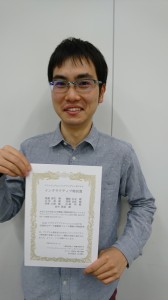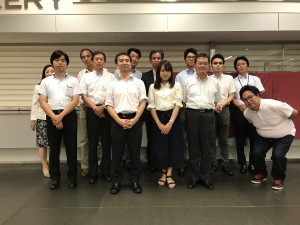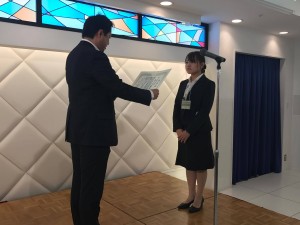本田 澄、情報処理学会 2016年度 研究会推薦博士論文速報(Generalized Software Reliability Model Considering Uncertainty and Dynamics: Theoretical Foundations and Empirical Applications)、2017年8月15日
M1 渡邊君ほか SES2017 インタラクティブ特別賞を受賞
ICST2017勉強会 まるわかりdayを開催、鷲崎教授が基調講演紹介
鷲崎弘宜, ICST 2017 基調講演 紹介, ICST2017勉強会(まるわかりday), 早稲田大学, 2017年8月26日
Prof. Washizaki gave a talk at NII Shonan meeting SENCPS
Prof. Washizaki gave a talk titled Goal-oriented modeling and traceability recovery for IoT Ecosystems at NII Shonan Meeting SENCPS.
Hironori Washizaki, Goal-oriented modeling and traceability recovery for IoT Ecosystems, NII Shonan Meeting SENCPS, Aug 23, 2017, Shonan Village
G7プログラミングラーニングサミット第3回・プログラミング教育明日会議を8月22日に開催
8月22日開催のプログラミング教育明日会議(早稲田大学グローバルソフトウェアエンジニアリング研究所共催)にて「G7プログラミングラーニングサミットとプログラミング学習ルーブリック」を講演。多くのご来場、有難うございました。
8月22日G7プログラミングラーニングサミット第3回を開催、プログラミング学習ツールのワークショップならびに展示を実施しました。多くのご参加ご支援有難うございました。写真は関係者集合の一コマ。この3回で1イテレーション目を終え、年内に改訂した2イテレーション目開始を予定しています。
B4 佐々木さんが「小学校におけるプログラミング教育において活用可能なルーブリックの提案」により日本デジタル教科書学会 若手優秀賞受賞
Program Learning for Beginners: Survey and Taxonomy of Programming Learning Tools, accepted at ICEED 2017
Daisuke Saito, Ayana Sasaki, Hironori Washizaki, Yoshiaki Fukazawa, Yusuke Muto, “Program Learning for Beginners: Survey and Taxonomy of Programming Learning Tools,” IEEE 9th International Conference on Engineering Education (ICEED 2017), Kanazawa, Japan, 9th-10th November 2017.
Programming is taught around the globe because it has become a vital skill. Occasionally a game or visual programming language tool designed for programming education is used to teach programming. In general, these tools have various attributes, which inhibit a great learning effect if the tool and learning objectives are not aligned. However, which tool is most appropriate for a given objective remains unknown. In this research, we propose a taxonomy table to evaluate program learning tools and demonstrate its usefulness by researching and comparing 43 kinds of program learning tools in the taxonomy table. This research should contribute to the selection of suitable tools for program learning.
Empirical Study on Recognition of Project Situations by Monitoring Application Results of Software Reliability Growth Model, accepted at FIARS 2017 (collocated with ISSRE)
Kiyoshi Honda, Hironori Washizaki, Yoshiaki Fukazawa, Masahiro Taga, Akira Matsuzaki and Takayoshi Suzuki, “Empirical Study on Recognition of Project Situations by Monitoring Application Results of Software Reliability Growth Model,” Fostering Industry-Academic Software Reliability Studies (FIARS) Workshop, Co-located with ISSRE 2017, October 23-26, Toulouse, France
Monitoring the results of software reliability growth models (SRGMs) helps evaluate project’s situations. SRGMs are used to measure the reliability of software by analyzing the relations between the number of detected bugs and the detected time to predict the number of remaining bugs within the software. For example, development managers apply a SRGM to the number of detected bugs and the detected time to predict the number of remaining bugs. Sometimes the SRGM results cause managers to make incorrect decisions because the results are temporary snapshots that change as a development progresses. We propose a method to help evaluate a project’s qualities by monitoring the results of SRGM applications. We collected the number of detected bugs and the detected time in the test phases for cloud services provided by e-Seikatsu Co., Ltd. to real estate businesses. The datasets contain about 34 cloud service features. The evaluation found that our method provides correct answers for 29 features and incorrect answers for 5 features.
A Student Placement Predictor for Programming Class Using Class Attitude, Psychological Scale, and Code Metrics accepted at ICCE 2017 (CORE Rank B)
Ryosuke Ishizue, Kazunori Sakamoto, Hironori Washizaki and Yoshiaki Fukazawa, “A Student Placement Predictor for Programming Class Using Class Attitude, Psychological Scale, and Code Metrics,” 25th International Conference on Computers in Education (ICCE 2017), Rydges Latimer hotel, Christchurch, New Zealand, December 4-8 2017.
It is often necessary to divide classes depending on students’ skill level and motivation to learn. However, it takes much time and effort for a teacher to measure and evaluate them. Because the teacher must prepare an examination and conduct it. Thus, we tried to predict results of placement from some materials without such an examination with machine-learning. The explanatory variables are 1. Psychological Scale, 2. Programming Task, and 3. Questionnaire about class. These are answered by university students in class to learn Java programming. The target variable is the result of placement based on the examination by a teacher of the class. As a result, we created a classification model whose F-measure is 0.91. Moreover, we investigated which explanatory variables affect how much results.
Two students advanced to ACM-ICPC Asia Tsukuba Regional.
From our group, two bachelor students (Ryo Ishiduka and Remin Kasahara) of team “Up to you” advanced to ACM-ICPC Asia Tsukuba Regional. Congratulations, and, good luck!
ACM-ICPC Asia Tsukuba Regional: 国内予選 結果と順位
http://icpc.iisf.or.jp/2017-tsukuba/results/



